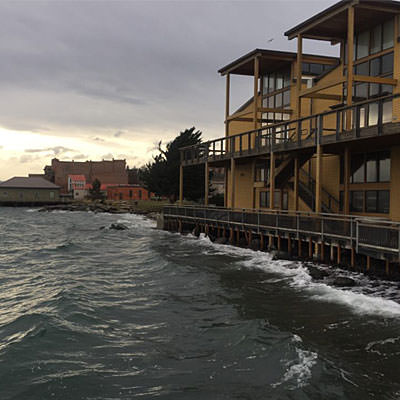Northeast outlook
Includes Maine, New Hampshire, Massachusetts, Connecticut, and New York
Why will they be higher than normal?
- A perigean spring tide will be occurring. This is when the moon is either new or full and closest to earth. Higher than normal high tides and lower than normal low tides will occur.
What kind of impact might I expect along the coast?
- Due to the topography of the northeast (less low lying areas), high tides alone will likely not cause a significant impact on the coast unless accompanied by a storm or strong winds.
Where might I expect high tide flooding?
- Tide stations at the following locations have the greatest chance of seeing high tide flooding: Boston, Massachusetts and Bar Harbor, Maine.
Mid-Atlantic outlook
Includes New Jersey, Delaware, Pennsylvania, Maryland, District of Columbia, Virginia
When will the tides be higher than normal?
- The Mid Atlantic is unlikely to experience coastal flooding based primarily on tides this winter.
Why won’t the Mid Atlantic be impacted?
- Though a perigean spring tide will occur in January and February, mean water levels will be lower due to decreasing water temperatures and changing weather patterns.
Southeast outlook
Includes North Carolina, South Carolina, Georgia, Eastern Florida coast
When will the tides be higher than normal?
- The Southeast is unlikely to experience coastal flooding based primarily on tides this winter.
Why won’t the Southeast be impacted
- Though a perigean spring tide will occur in January and February, mean water levels will be lower due to decreasing water temperatures and changing weather patterns.
Gulf Coast outlook
Includes Texas, Louisiana, Mississippi, Alabama, Western Florida coast
When will the tides be higher than normal?
- The Gulf Coast will not be significantly impacted.
Why won’t they be impacted?
- In many locations of the Gulf Coast, the tidal range is relatively small compared to other regions of the U.S, so they will not be as significantly impacted by a perigean spring tide.
West Coast outlook
Includes California, Oregon, Washington State
When will the tides be higher than normal?
- December 11-14, 22-28
- January 9-13
- February 7-11
Why will they be higher than normal?
- A perigean spring tide will be occurring in January and February. This is when the moon is either new or full and closest to earth. Higher than normal high tides and lower than normal low tides will occur.
- The increased angle of the sun relative to the Earth, which reaches a maximum during the Winter Solstice (December 21).
Where might I expect High Tide Flooding?
- Tide stations at the following locations have the greatest chance of seeing high tide flooding: - Humboldt Bay, California; South Beach, Oregon; Toke Point, Washington
Hawaii and the Pacific Islands outlook
Includes Hawaii, Guam, American Samoa, Midway, Kwajalein, and Wake Island
When will the tides be higher than normal?
Why will they be higher than normal?
- A perigean spring tide will be occurring in January and February. This is when the moon is either new or full and closest to earth. Higher than normal high tides and lower than normal low tides will occur.
Where might I expect High Tide Flooding?
- Tide stations at the following locations have the greatest chance of seeing high tide flooding: Kwajalein, Marshall Islands.
ALASKA outlook
When will the tides be higher than normal?
- December 11-14, 23-27
- January 10-13
- February 8-13
Why will they be higher than normal?
- A perigean spring tide will be occurring in January and February. This is when the moon is either new or full and closest to earth. Higher than normal high tides and lower than normal low tides will occur.
- The increased angle of the sun relative to the Earth, which reaches a maximum during the Winter Solstice (December 21).
What kind of impact might I expect along the coast?
- Due to the topography, in particular for southeast Alaska (less low lying areas), tidal flooding will generally not have a significant impact on the coast unless there is a severe storm.
 An official website of the United States government.
An official website of the United States government.


Social